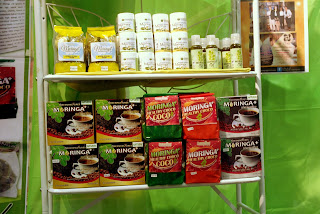Moringa is a small tree that grows in the tropical regions
of the word. It is called “malunggay” or “kalamunggay” in the Philippines. The
plant can grow as high as 10 to 20 feet. Its bark is whitish gray which is surrounded with
thick cork. The leaves are round and small, and the pods are long and slender.
Despite the softness of the plant’s wood and tender parts,
moringa is in fact a hardy plant. In tropical climate it grows fast in almost
any type of soil and is resistant to drought. Even a discarded trunk or branch on
the ground will sprout young leaves and a new plant grows. The plant can be
propagated through its seeds or cuttings. Moringa is easy to cultivate. A grown
plant can sustain itself without much care and cultivation. In most cases
fertilizer and pesticide are not necessary.
Moringa is primarily planted for its leaves and green pods as
vegetable. The leaves are added in fish soup and chicken based dish that is
called “tinola” and in vegetable dishes that are creamed with coconut milk. The
plant is dubbed as a “poor man’s vegetable” because of its cheapness and
abundance. In our family, we used to have plenty of this plant in our compound
which also served as border fence in the sloping portion of our land. The plants
had lush leaves and plentiful fruits. But we seldom harvest them, and if we did
we only used the leaves and left the pods alone. Other people could help
themselves with the leaves and the pods if they asked for them.
The leaves are the most nutritious parts of the plants. Like
almost green leafy vegetables , the moringa leaves contain Vitamins B, C and K,
beta carotene, potassium, manganese,
protein and other special nutrients. Because of its nutritional value moringa
is recommended by the government for consumption of lactating mothers and
children. Some bread such as “pan de sal” and noodles are fortified with
moringa leaves to enhance its nutritional contents.
The hype that some herbs, fruits and vegetables have
medicinal properties that are at par or better than conventional drugs has
created an impression to some people that herbal products offer hope for the
treatment of diseases such as hypertension, diabetes and even cancer. However,
health authorities have warned people over the use of those products as
alternative medicines because official confirmation has yet to be issued
regarding their effectiveness.
Moringa is used to be regarded only as a backyard plant
because of its low commercial importance, but now some farmers cultivate it in
large scale because of the increasing demand of natural herbal products for
food supplement and alternative medicines. Moringa leaves are dried and made into
organic powder, capsule, oil, tea, food supplement and other products. Aside
from consuming the leaves as vegetable, locals use it also in traditional
medicine. As an example, a cup of boiled moringa leaves is used to treat
constipation.




No comments:
Post a Comment